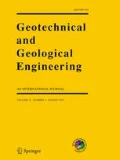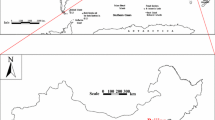Abstract
Based on the combination of FLAC3D software and strength reduction method, the applicability of three kinds of instability criterion of the stability of dip slopes with interbeddings of weak and hard rocks is studied. Then the failure process, failure mode and stability of the slopes are analyzed. The results show that: (1) the maximum unbalance rate affects the final calculated results; there is no certain relation between the convergence of calculation and the slope stability. The convergence of the displacement curves of key points and the ultimate displacement values should also be concerned to determine the slope stability. The maximum unbalance rate and the amplitude of the reduction affect the determination of the characteristic point in the displacement curve. It is difficult to quantitatively evaluate the shear strain rate when judging the slope stability, the judgment is not convenient and the error is large. Combining with calculation convergence criterion and feature point displacement mutation criterion is helpful to improve the accuracy of judgment on the limit state of the slope. (2) Slope deformation and failure process can be roughly divided into four stages qualitatively; the rock mass has buckling failure can be divided into three stages according to the deformation characteristics. The potential shear export of slope with buckling failure locates above the slope toe. Different combinations of weak and strong rock thickness does not affect the failure mode of slope, which all bellows to buckling failure mode, but it will affect the slope stability coefficient; with the increase of the thickness of strong rock and weak rock, the stability coefficient increases. If the thickness of the strong rock increases, the stability coefficient increases as well when the thickness ratio is constant.








Similar content being viewed by others
References
Chen LH, Jin XG (2012) Study on the applicability of three criteria for slope instability using finite element strength reduction method. China Civ Eng J 45(9):136–146
Dawson EM, Roth WH, Drescher A (1999) Slope stability analysis by strength reduction. Geotechnique 49(6):835–840
He J, Shi JT, Huang L et al (2014) Applicability research on instability criterions for inhomogeneous layered slope using strength reduction method. Yellow River 36(12):122–125
Li H, Gong BN, Chen Y (2007) Study on criteria for evaluating stability of slope with FEM based on shear strength reduction methods. J Water Resour Archit Eng 5(01):79–82
Lian ZY, Han GC, Kong XJ (2001) Stability analysis of excavation by strength reduction FEM. Chin J Geotech Eng 23(4):407–411
Liao L, Zhu Y, Yang Z et al (2016) Buckling analysis of bedded rock slope subject to seismic force—a case study in Karakoram Highway, Pakistan. Int J Geohazards Environ 2(1):17–24
Liu CX, Zhu YW (2014) Buckling failure mode of inclination-paralleled rock slopes. J Geol Hazards Environ Preserv 25(1):82–86
Liu JL, Luan MT, Zhao SF et al (2005) Discussion on criteria for evaluating stability of slope in elastoplastic FEM based on shear strength reduction technique. Rock Soil Mech 26(08):1345–1348
Luan MT, Wu YJ, Nian TK (2003) A criterion for evaluating slope stability based on development of plastic zone by shear strength reduction FEM. J Disaster Prev Mitig Eng 23(3):1–8
Lv Q, Sun HY, Shang YQ (2008) Slope failure criteria of shear strength reduction finite element method. J Zhejiang Univ (Eng Sci) 42(01):83–87
Pei LJ, Qu BN, Qian SG (2010) Uniformity of slope instability criteria of strength reduction with FEM. Rock Soil Mech 31(10):3337–3341
Tang HM, Chen HK, Cao WM (2011) Model experiment in excavation of rock bedding slope. Rock Soil Mech 32(2):435–440
Tang MG, Ma X, Zhang TT et al (2016) Early recognition and mechanism of creep-buckling of bedding slope. J Eng Geol 24(3):442–450
Tommasi P, Verrucci L, Campedel P et al (2009) Buckling of high natural slopes: the case of Lavini di Marco (Trento-Italy). Eng Geol 109(1):93–108
Zhao SY, Zheng YR, Shi WM et al (2002) Analysis on safety factor of slope by strength reduction FEM. Chin J Geotech Eng 24(3):343–346
Zhao SY, Zheng YR, Zhang YF (2005) Study on slope failure criterion in strength reduction finite element method. Rock Soil Mech 26(2):332–336
Zhen H, Li CG, Li CF et al (2002) Finite element method for solving the factor of safety. Chin J Geotech Eng 24(05):626–628
Zheng YR, Zhao SY, Deng WD (2003) Numerical simulation on failure mechanism of rock slope by strength reduction Fem. J Rock Mech Eng 22(12):1943–1952
Zheng YR, Zhao SY, Song YK (2005) Advance of study on the strength reduction finite element method. J Logist Eng Univ 21(3):1–6
Acknowledgements
This work is supported by National Natural Science Foundation of China (41672317).
Author information
Authors and Affiliations
Corresponding author
Rights and permissions
About this article
Cite this article
Yao, W., Hu, B., Ma, C. et al. Applicability Research on the Dip Slope with Interbeddings of Weak and Strong Rocks Using Strength Reduction Method. Geotech Geol Eng 35, 1111–1118 (2017). https://doi.org/10.1007/s10706-017-0167-2
Received:
Accepted:
Published:
Issue Date:
DOI: https://doi.org/10.1007/s10706-017-0167-2




